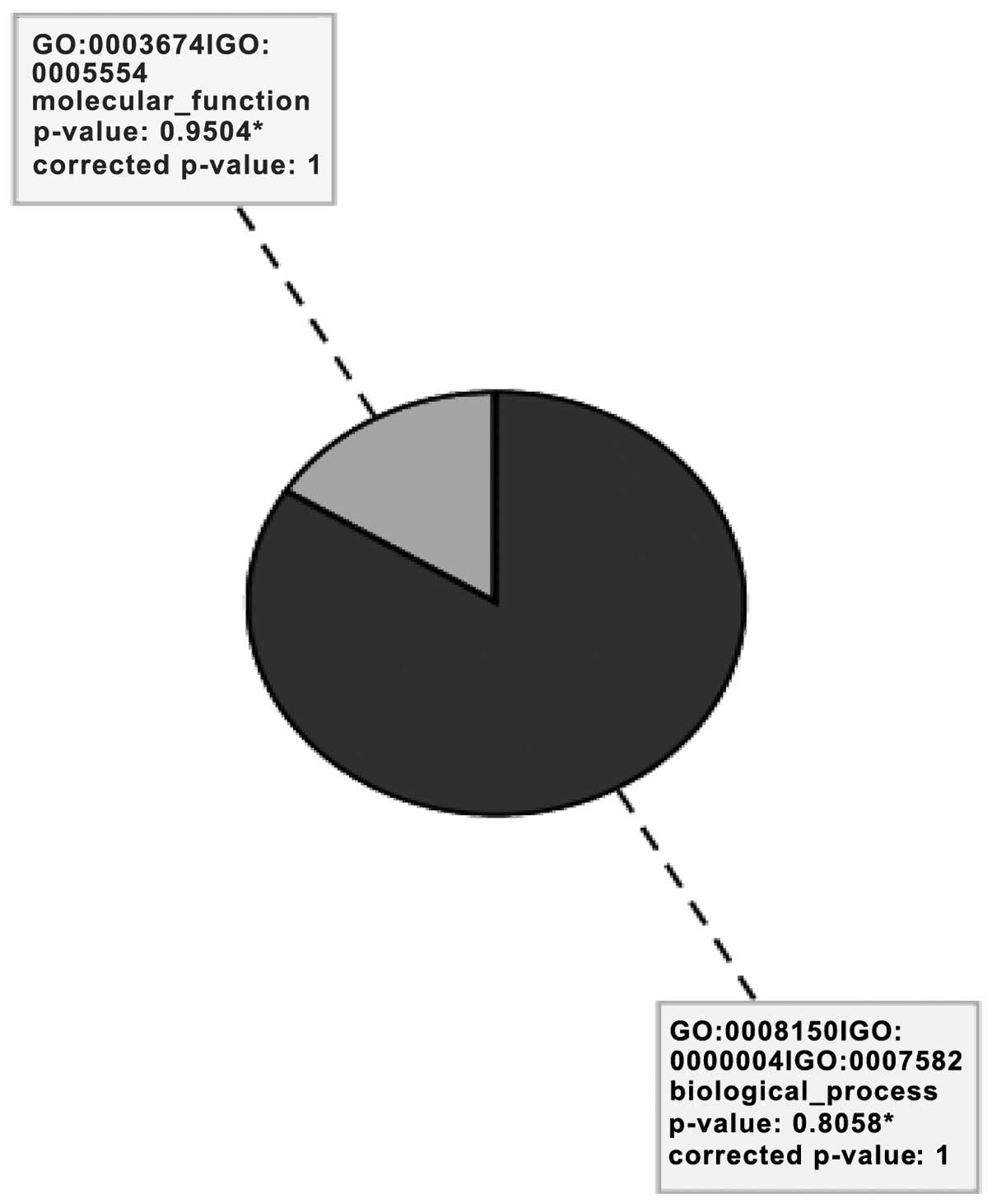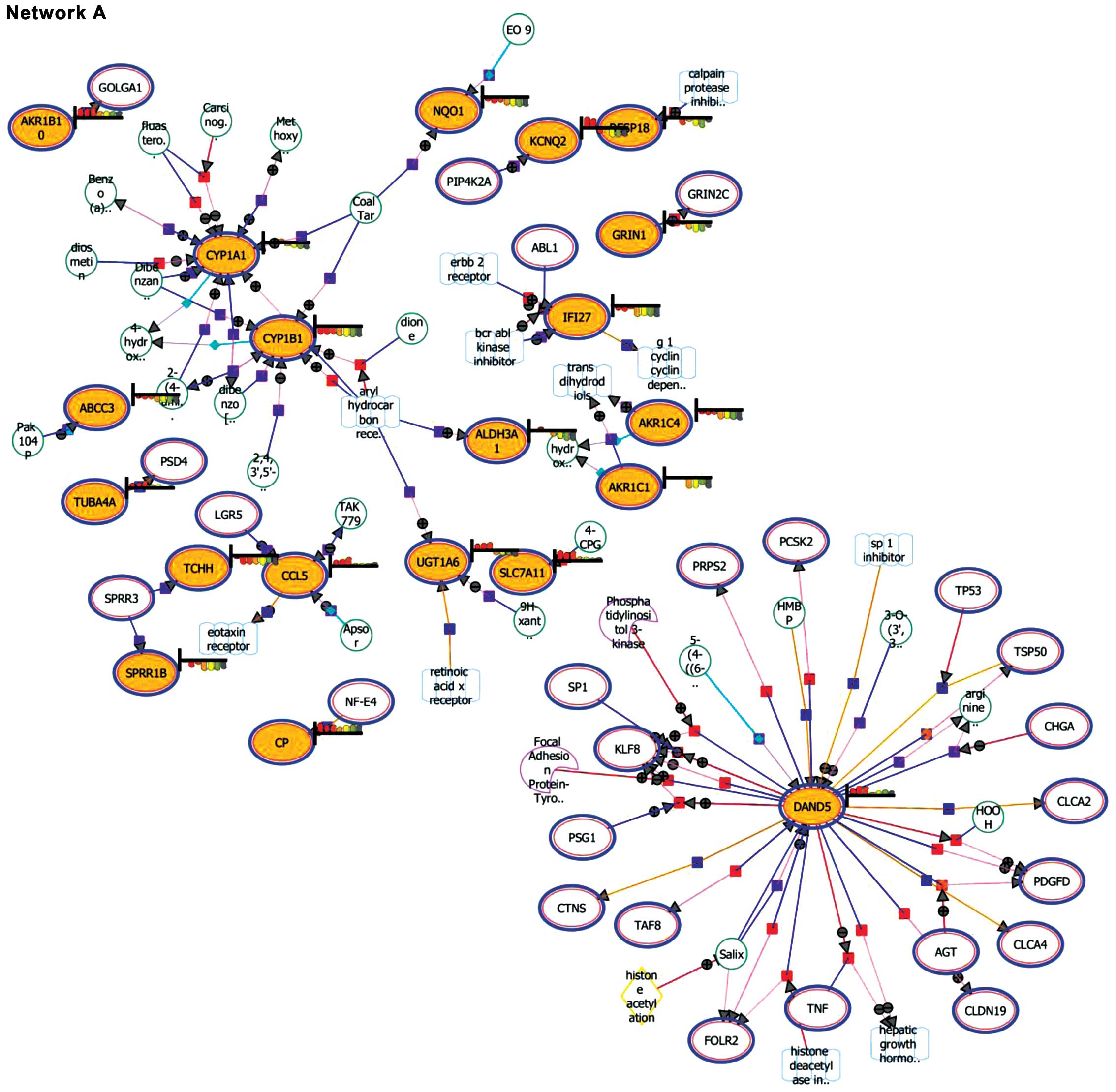|
1
|
IARC. World Cancer Report. Geneva: World
Health Organization; Lyon: 2008, http://www.iarc.fr/en/publications/pdfs-online/wcr/2008/index.php.
|
|
2
|
Banerjee S, Azmi AS, Padhye S, et al:
Structure-activity studies on therapeutic potential of Thymoquinone
analogs in pancreatic cancer. Pharm Res. 27:1146–1158. 2010.
View Article : Google Scholar : PubMed/NCBI
|
|
3
|
Woo C, Loo SY, Gee V, et al: Anticancer
activity of thymoquinone in breast cancer cells: possible
involvement of PPAR-gamma pathway. Biochem Pharmacol. 82:464–475.
2011. View Article : Google Scholar : PubMed/NCBI
|
|
4
|
Gali-Muhtasib H, Diab-Assaf M, Boltze C,
Al-Hmaira J, Hartig R, Roessner A and Schneider-Stock R:
Thymoquinone extracted from black seed triggers apoptotic cell
death in human colorectal cancer cells via a p53-dependent
mechanism. Int J Oncol. 25:857–866. 2004.PubMed/NCBI
|
|
5
|
El-Mahdy MA, Zhu Q, Wang QE, Wani G and
Wani AA: Thymoquinone induces apoptosis through activation of
caspase-8 and mitochondrial events in p53-null myoloblastic
leukemia HL-60 cells. Int J Cancer. 117:409–417. 2005. View Article : Google Scholar : PubMed/NCBI
|
|
6
|
Rugo HS: The breast cancer continuum in
hormone-receptor-positive breast cancer in postmenopausal women:
evolving management options focusing on aromatase inhibitors. Ann
Oncol. 19:16–27. 2007. View Article : Google Scholar
|
|
7
|
Fisher B, Costantino JP, Wickerham DL, et
al: Tamoifen for prevention of breast cancer: report of the
National Surgical Adjuvant Breast and Bowel Project P-1 Study. J
Natl Cancer Inst. 90:1371–1388. 1998. View Article : Google Scholar : PubMed/NCBI
|
|
8
|
Jordan VC: Chemoprevention of breast
cancer with selective oestrogen-receptor modulators. Nat Rev.
7:46–53. 2007. View
Article : Google Scholar : PubMed/NCBI
|
|
9
|
Duursen MB: Estrogen metabolizing enzymes:
biomarkers of exposure, effect and susceptibility for
carcinogenesis (Dissertation). Proefschrift Universiteit Utrecht
Press; 2005
|
|
10
|
de Padua Mansur A, Silva TC, Takada JY, et
al: Long-term prospective study of the influence of estrone levels
on events in postmenopausal women with or at high risk for coronary
artery disease. ScientificWorldJournal. 2012:3635952012.PubMed/NCBI
|
|
11
|
Zhou J and Seidel E: Estrogens induce
visfatin expression in 3T3-L1 cells. Peptides. 31:271–274. 2010.
View Article : Google Scholar : PubMed/NCBI
|
|
12
|
Abrahamsson A, Morad V, Saarinen N and
Dabrosin C: Estradiol, tamoxifen, and flaxseed alter IL-1beta and
IL-1Ra levels in normal human breast tissue in vivo. J Clin
Endocrinol Metab. 97:E2044–E2054. 2012. View Article : Google Scholar : PubMed/NCBI
|
|
13
|
Androutsopoulos VP, Tsatsakis AM and
Spandidos DA: Cytochrome P450 CYP1A1: wider roles in cancer
progression and prevention. BMC Cancer. 9:1872009. View Article : Google Scholar : PubMed/NCBI
|
|
14
|
Furukawa M, Nishimura M, Ogino D, et al:
Cytochrome p450 gene expression levels in peripheral blood
mononuclear cells in comparison with the liver. Cancer Sci.
95:520–529. 2004. View Article : Google Scholar : PubMed/NCBI
|
|
15
|
Fu J, Weise A, Falany J, et al: Expression
of estrogenicity genes in a lineage cell culture model of human
breast cancer progression. Breast Cancer Res Treat. 120:35–45.
2010. View Article : Google Scholar : PubMed/NCBI
|
|
16
|
Zhao YN, Zhang W, Chen YC, Fang F and Liu
XQ: Relative imbalances in the expression of
catechol-O-methyltransferase and cytochrome P450 in breast
cancer tissue and their association with breast carcinoma.
Maturitas. 72:139–145. 2012.PubMed/NCBI
|
|
17
|
Gajjar KL, Martin-hirsch PL and Martin FL:
CYP1B1 and hormone-induced cancer. Cancer Lett. 324:13–30. 2012.
View Article : Google Scholar : PubMed/NCBI
|
|
18
|
Mikstack R, Rimando AM, Dutkiewicz Z,
Stefanski T and Sobiak S: Design, synthesis and evaluation of the
inhibitory selectivity of novel transresveratrol analogues on human
recombinant CYP1A1, CYP1A2 and CYP1B1. Bioorg Med Chem.
20:5117–6126. 2012. View Article : Google Scholar : PubMed/NCBI
|
|
19
|
Ashley-Martin J, Vanleeuwen J, Cribb A,
Andreou P and Guernsey JR: Breast cancer risk, fungicide exposure
and CYP1A1*2A gene-environment interactions in a
province-wide case control study in Prince Edward Island, Canada.
Int J Environ Res Publ Health. 9:1846–1858. 2012.PubMed/NCBI
|
|
20
|
Williams-Brown MY, Salih SM and Xu X: The
effect of tamoxifen and raloxifene on estrogen metabolism and
endometrial cancer risk. J Steroid Biochem Mol Biol. 126:78–86.
2012. View Article : Google Scholar : PubMed/NCBI
|
|
21
|
Scornaienchi ML, Thornton C, Willett KL
and Wilson JY: Cytochrome P450-mediated 17b-estradiol metabolism in
zebrafish (Danio rerio). J Endocrinol. 206:317–325. 2010.
View Article : Google Scholar : PubMed/NCBI
|
|
22
|
Han EH, Kim HG, Hwang YP, Song GY and
Jeong HG: Prostaglandin E2 induces CYP1B1 expression via
ligand-independent activation of the ERalpha pathway in human
breast cancer cells. Toxicol Sci. 114:204–216. 2010. View Article : Google Scholar : PubMed/NCBI
|
|
23
|
Guengerich PF, Chun Y, Kim D, Gillam E and
Shimada T: Cytochrome P450 1B1: a target for inhibition in
anticarcinogenesis strategies. Mutat Res. 523–524:173–182.
2003.PubMed/NCBI
|
|
24
|
Zahid M, Kohli E, Saeed M, Rogan E and
Cavalieri E: The greater reactivity of estradiol-3,4-quinone vs
estradiol-2,3-quinone with DNA in the formation of depurinating
adducts: implications for tumor-initiating activity. Chem Res
Toxicol. 19:164–172. 2006. View Article : Google Scholar : PubMed/NCBI
|
|
25
|
Lakhani NJ, Sarkar MA, Venitz J and Figg
WD: 2-Methoxyestradiol, a promising anticancer agent.
Pharmacotherapy. 23:165–172. 2003. View Article : Google Scholar : PubMed/NCBI
|
|
26
|
Newman SP, Foster PA, Stengel C, et al:
STX140 is efficacious in vitro and in vivo in taxane-resistant
breast carcinoma cells. Clin Cancer Res. 14:597–606. 2008.
View Article : Google Scholar : PubMed/NCBI
|
|
27
|
Verenich S and Gerk PM: Therapeutic
promises of 2-methoxyestradiol and its drug disposition challenges.
Mol Pharm. 7:2030–2039. 2010. View Article : Google Scholar : PubMed/NCBI
|
|
28
|
Huang Y, Dai Z, Barbacioru C and Sadee W:
Cystine-glutamate transporter SLC7A11 in cancer chemosensitivity
and chemoresistance. Cancer Res. 65:7446–7454. 2005. View Article : Google Scholar : PubMed/NCBI
|
|
29
|
Krishna R and Mayer LD: Multidrug
resistance (MDR) in cancer: mechanisms, reversal using modulators
of MDR and the role of MDR modulators in influencing the
pharmacokinetics of anticancer drugs. Eur J Pharm Sci. 11:265–283.
2000. View Article : Google Scholar : PubMed/NCBI
|
|
30
|
Weichselbaum RR, Ishwaran HYT, Nuyten DSA,
et al: An interferon-related gene signature for DNA damage
resistance is a predictive marker for chemotherapy and radiation
for breast cancer. Proc Natl Acad Sci USA. 105:18490–18495. 2008.
View Article : Google Scholar : PubMed/NCBI
|
|
31
|
Luker KE, Pica CM, Schreiber RD and
Piwnica-Worms SD: Overexpression of IRF9 confers resistance to
antimicrotubule agents in breast cancer cells. Cancer Res.
61:6540–6547. 2001.PubMed/NCBI
|
|
32
|
Camaj P, Ischenko I, Seeliger H, Arnold G,
Jauch KW and Bruns CJ: Overexpression of the gene IFIT3 enhances
tumor growth, angiogenesis, metastasing and chemoresistance of the
pancreas carcinoma cells. In: Chirurgisches Forum und DGAV Forum;
2009; 38. Springer; Berlin Heidelberg: pp. 17–18. 2009
|
|
33
|
Cheriyath V, Kuhns MA, Jacobs BS, et al:
G1P3, an interferon- and estrogen-induced survival protein
contributes to hyperplasia, tamoxifen resistance and poor outcomes
in breast cancer. Oncogene. 31:2222–2236. 2012. View Article : Google Scholar : PubMed/NCBI
|
|
34
|
Veals SA, Schindler C, Leonard D, Fu XY,
Aebersold R, Darnell JE Jr and Levy DE: Subunit of an
alpha-interferon-responsive transcription factor is related to
interferon regulatory factor and Myb families of DNA-binding
proteins. Mol Cell Biol. 12:3315–3324. 1992.
|
|
35
|
Wong LH, Hatzinisiriou I, Devenish RJ and
Ralph SJ: IFN-γ priming up-regulates IFN-stimulated gene factor 3
(ISGF3) components, augmenting responsiveness of IFN-resistant
melanoma cells to type I IFNs. J Immunol. 160:5475–5484. 1998.
|
|
36
|
Englert NA, Spink BC and Spink DC:
Persistent and non-persistent changes in gene expression result
from long-term estrogen exposure of MCF-7 breast cancer cells. J
Steroid Biochem Mol Biol. 123:140–150. 2011. View Article : Google Scholar : PubMed/NCBI
|
|
37
|
Pham AN, Bower PE, Alvardo O, Ravula R,
Gout PW and Huang Y: Pharmacogenomic approach reveals a role for
the x(c)- cystine/glutamate antiporter in growth and celastrol
resistance of glioma cell lines. J Pharmacol Exp Ther. 323:949–958.
2010. View Article : Google Scholar : PubMed/NCBI
|
|
38
|
Lin G, Aranda V, Muthuswamy SK and Tonks
NK: Identification of PTPN23 as a novel regulator of cell invasion
in mammary epithelial cells from a loss-of-function screen of the
‘PTP-ome’. Genes Dev. 25:1412–1425. 2011.PubMed/NCBI
|
|
39
|
Su PH, Lin YW, Huang RL, et al: Epigenetic
silencing of PTPRR activates MAPK signaling, promotes metastasis
and serves as a biomarker of invasive cervical cancer. Oncogene.
32:15–26. 2012.PubMed/NCBI
|
|
40
|
Arafa el-SA, Zhu Q, Shah ZI, Wani G,
Barakat BM, Racoma I, El-Mahdy MA and Wani AA: Thymoquinone
up-regulates PTEN expression and induces apoptosis in
doxorubicin-resistant human breast cancer cells. Mutat Res.
706:28–35. 2011. View Article : Google Scholar : PubMed/NCBI
|












